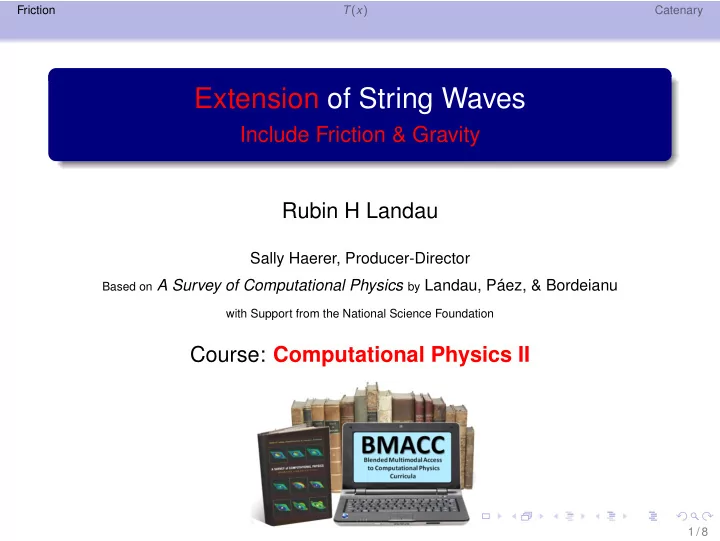

Friction T ( x ) Catenary Extension of String Waves Include Friction & Gravity Rubin H Landau Sally Haerer, Producer-Director Based on A Survey of Computational Physics by Landau, Páez, & Bordeianu with Support from the National Science Foundation Course: Computational Physics II 1 / 8
Friction T ( x ) Catenary Including Friction (Easy Numerically) ∆ y(x,t) θ x L ∆ How Include Friction in Wave Equation? Observation: Real strings don’t vibrate forever Model: String element in viscous fluid ( κ ) Frictional force opposes motion, ∝ v , ∆ x : F f ≃ − 2 κ ∆ x ∂ y (1) ∂ t Modified wave equation (Additional RHS Force) ∂ 2 y ∂ t 2 = c 2 ∂ 2 y ∂ x 2 − 2 κ ∂ y (2) ρ ∂ t 2 / 8
Friction T ( x ) Catenary Exercise Do On Your Own Generalize wave equation algorithm to include friction 1 Solve wave equation 2 Check that wave decays, or not ( κ = 0) 3 Unstable: κ < 0? 4 Pick large enough κ to see effect; if too large? 5 loading CatFrictionAnimate 3 / 8
Friction T ( x ) Catenary Another Extension: Variable Tension, Density ∆ y(x,t) θ x L ∆ � T /ρ ; constant T , ρ c = ↑ ρ ⇒↑ T to accelerate ⇒ fast & slow; adiabatic Thick chain ends; g g , ρ ( x ) ⇒ T ( x ) , c ( x ) Newton for element: F = ma (3) ∆ x = ρ ( x )∆ x ∂ 2 y ( x , t ) ∂ � T ( x ) ∂ y ( x , t ) � (4) ∂ x ∂ x ∂ t 2 + T ( x ) ∂ 2 y ( x , t ) = ρ ( x ) ∂ 2 y ( x , t ) ∂ T ( x ) ∂ y ( x , t ) (5) ∂ x ∂ x ∂ x 2 ∂ t 2 4 / 8
Friction T ( x ) Catenary Discretized Wave Equation with T ( x ) ρ ( x ) = ρ 0 e α x , T = T O e α x Trial Case: ρ ( x ) ∂ 2 y ( x , t ) + T ( x ) ∂ 2 y ( x , t ) = ∂ T ( x ) ∂ y ( x , t ) (1) ∂ t 2 ∂ x ∂ x ∂ x 2 Difference equation via central-difference derivatives: y i , 2 = y i , 1 + c 2 c ′ 2 [ y i + 1 , 1 + y i − 1 , 1 − 2 y i , 1 ] + α c 2 (∆ t ) 2 [ y i + 1 , 1 − y i , 1 ] (2) 2 ∆ x Try standing waves y ( x , t ) = A cos ( ω t ) sin ( kx ) Verify ω ≤ ω cut ⇒ no solution 5 / 8
Friction T ( x ) Catenary Hanging String at Rest: Derivation of Catenary u ds T dx ds T0 D W x u ( x ) , T ( x ) =? Chains sag Free-body diagram T ( x ) : ends support middle W =section weight = T y u ( x ) = equilibrium shape, y ( x ) = disturbance s = arc length: 6 / 8
Friction T ( x ) Catenary Hanging String: Derivation of Catenary (Cont) u ds T dx ds T0 D W x T ( x ) sin θ = W = ρ gs , T ( x ) cos θ = T 0 , (1) tan θ = ρ gs / T 0 (2) ⇒ Trick: convert to ODE, solve ODE (see text) u ( x ) = D cosh x NB Special Origin) (3) D T ( x ) = T 0 cosh x def D , D = T 0 /ρ g (4) Now know T ( x ) for wave equation + T ( x ) ∂ 2 y ( x , t ) = ρ ( x ) ∂ 2 y ( x , t ) ∂ T ( x ) ∂ y ( x , t ) (5) ∂ x 2 ∂ t 2 ∂ x ∂ x 7 / 8
Friction T ( x ) Catenary Implementation: Catenary and Frictional Waves Modify EqString.py to include friction and g 1 Look for interesting cases, create surface plots 2 Point out non uniform damping. 3 Are standing waves (normal modes) possible? 4 u ( x , t ) = A cos ( ω t ) sin ( γ x ) t = 1 2 u(x,t) 3 4 5 6 (Get to work!) x 8 / 8
Recommend
More recommend